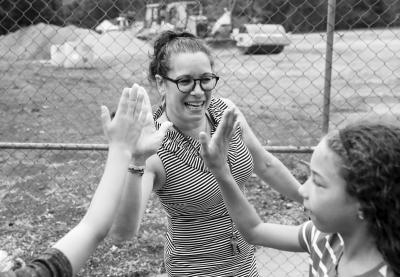Lisa Molinaro began her career in education as a 20-year-old at the all-boys George Junior Republic juvenile delinquent center in Grove City, Pennsylvania. Her students were primarily young black males between the ages of 13 and 17 years, 11 months and 29 days.
When they turned 18—depending on the crime they committed—they could be sent away to jail, just like that, to serve the rest of their time.
“There wasn’t a single kid that I had a conversation with who saw school positively,” Molinaro remembers.
Those kids inform her philosophy 33 years later as she leads the transformation of Woodbrook Elementary into a culturally responsive school from the principal’s office.
“My mission has never changed,” Molinaro says. “The most harmful thing to our country and our world is an ill-educated system.”
Woodbrook once housed a predominately white, upper-middle class student population. Then, a new school opened to the north. The longtime principal left to lead the newer, bigger school. At the same time, two affordable housing units opened up in the area.
The student population transformed. Portions of the staff left. The principal’s office became a revolving door of changing leadership. And the school had no identity.
“There had not been enough continuous leadership to build anything new culturally,” Molinaro explains. “I inherited some things where I was like, ‘Wow. Where am I?’”
In a full-size trailer behind the school, Molinaro witnessed a dozen kids grab busywork from milk crates sitting on a table. Then they sat in silence. The “suspension center” featured mostly kids of color—removed, literally and symbolically, from vital learning opportunities.
“We’re never going to move these kids in the direction we need to move them if their entire day is spent out of their classroom,” Molinaro says. “We are sending the message, ‘You do not belong here.’ If we’re saying you don’t belong here, don’t even ask the kid to open his brain up to learning.”
Today—seven years since Molinaro’s arrival—Woodbrook looks very different. The staff better reflects a diverse student body. Only three students were suspended last year, and instead of a trailer out back, a construction crew works to help expand the school. Students no longer sit, inactive, in the hallways. They move about nontraditional classrooms. They take action, engage in marches, fundraise for Hurricane Harvey victims. Achievement gaps for English language learners trend narrower than most schools, with pass rates soaring past 80 percent.
Woodbrook Elementary Demographics
Students: 365
White students: 44.1 percent
Black students: 25.8 percent
Hispanic students: 20.5 percent
Asian students: 4.7 percent
Two or more races: 4.7 percent
Economically disadvantaged: 48.8 percent
Molinaro credits this to the implementation of responsive classroom and culturally responsive teaching and hiring exemplary teachers who practice what she preaches.
But she knows there is still work to do. That some achievement gaps at Woodbrook—while slowly closing—take her back to Grove City, her first job and her first encounter with educational injustice.
“What I know is that we are missing the kids I started my career with,” Molinaro says. “We’re missing the kids that could end up where I started.”
So this year, Molinaro aims to change that. It begins with a simple call to action for her teachers. A universal goal all educators can strive toward.
Molinaro showed her teachers a TED Talk from writer Chimanda Ngozie Adichie, who spoke about the danger of a single story, and how her being African informed the way the world interacted with her before it knew her.
“This is what schools do,” Molinaro told her teachers. “We write stories and we perpetuate them for 12 years, 13 years. I want you to take the time this year to change that story.”
